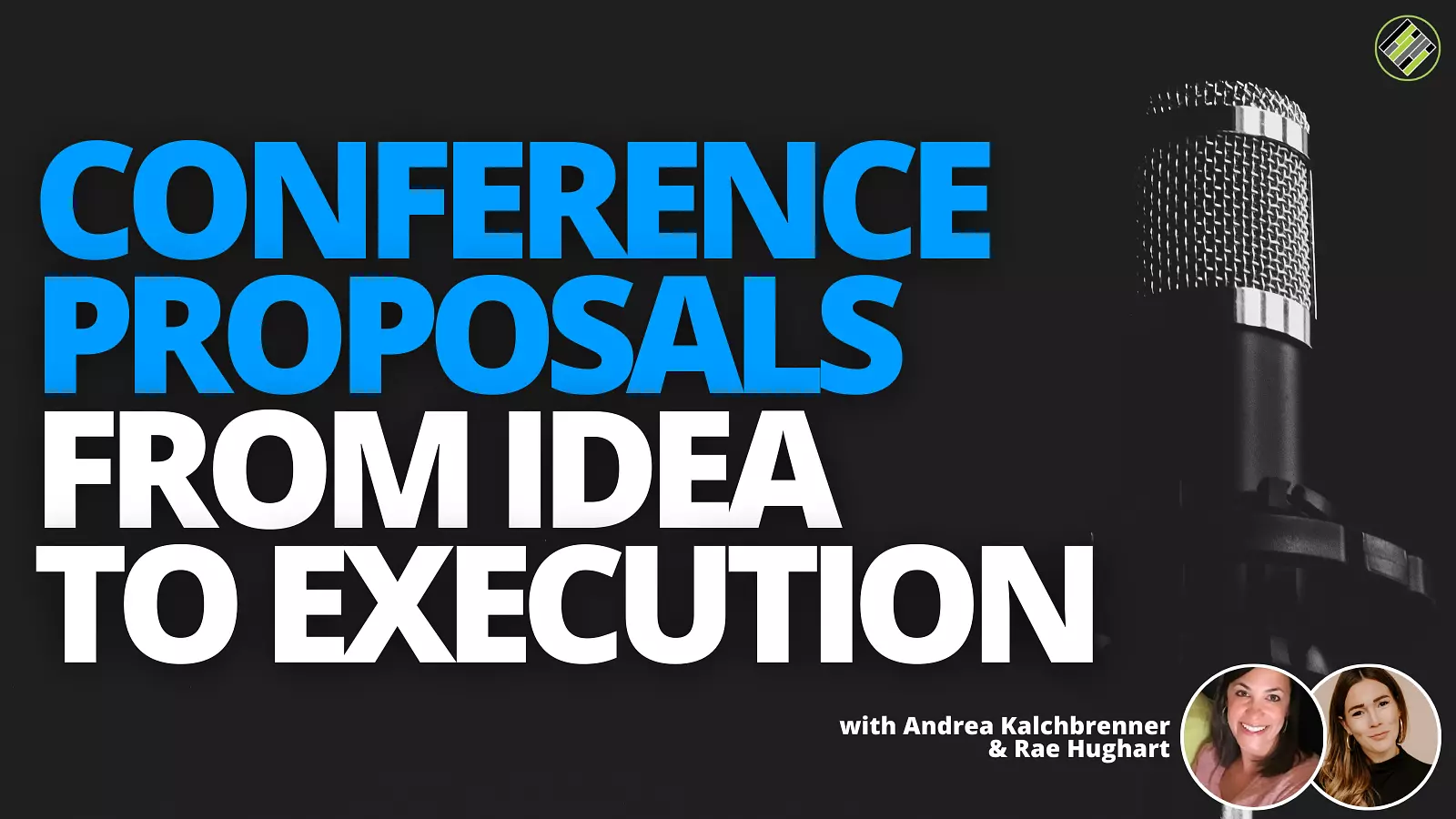TL;DR:
- Mistakes are opportunities for growth if you learn from them.
- Have a backup presentation saved and/or bring notes in case something happens to your presentation plans.
- Invest in an adaptor that can allow your presentation to work with Mac or PC equipment.
- Use the microphone! You don’t want to lose your voice.
- Embed any video clips into the actual presentation.
- End your presentation on time so the next person has time to prep and people can move freely to the next event.
Learn From My 5 Mistakes When Presenting at an Event
Todd joined Rae on the Daily Drop In to talk about presenting at an event.
Mistakes
Mistakes aren’t mistakes if you learn something from them. Of course, this is easier for someone who didn’t make the actual mistake. Instead, you get to benefit from watching someone else make theirs. The good news is that I am going to share with you some painful mistakes I have made while presenting. Hopefully, you can learn from them and avoid them.
The bad news is that even though you can avoid my mistakes, you cannot avoid your own. Use them as an opportunity to make yourself better as a speaker. Grow from them. Click To TweetBe sure you have a backup presentation/notes.
I was still relatively new to the presenting game and technology wasn’t as friendly as it is nowadays. I created a PowerPoint on my home computer. Because it would be difficult to lug my desktop computer to the venue, my plan was to use my school laptop to show the presentation.
Arriving at the presentation 10 minutes early so as to check my technology, I fired up the computer and plugged in my jumpdrive. When I clicked on my presentation folder, nothing happened. When it was clicked a second time, I got a message that asked me what program I wanted to open the file. Microsoft PowerPoint was not an option.
What I hadn’t realized was that my school computer didn’t have the Microsoft Office programs that my desktop did. There were no Google Slides back then. I was screwed. Frantically, I tried for 15 minutes to download a program that would allow me to use my presentation. This was under the careful eyes of an audience of around 50 people.
Realizing I was supposed to be 10 minutes into my presentation at this point, I decided to just give the presentation anyway. Unfortunately, I had not prepared any notes as I was just going to use the text on my slides to guide my speaking. I knew my topic and had a general idea of the format my speech was to take but was definitely out of my comfort level.
Now I always have a set of printed notes in case something like this happens.
Be your own IT person.
I have been at many presentations where the person speaking does not know how to use their own technology. This could be anything from figuring out how to hook up to the projector to not understanding how to access a file. They are helpless unless there is a technology person there to help.
I once presented a keynote with an individual who could not get her video to work. She spent half of her allotted time trying to fix it. Even when she did start speaking she had trouble getting into her topic because she was flustered.
I try my hardest to keep up with technology so that I am ready to step in and figure it out myself. I would rather not have to wait for the organizers to locate the IT person. Even when you think you are prepared, something will still go wrong.
I was giving a presentation at a university that was not a Mac school. I don’t mean the Mid-American Conference (go Falcons) but rather they were a school that preferred to use PCs. Because of this, the dongle that connected my Mac to the LCD hub was not compatible. It was literally like trying to fit a square peg in a round hole.
I lucked out that someone in the audience had a universal adapter that allowed you to connect to any sort of presentation device. I hooked this up, gave my presentation, and 5 minutes after I was done, had ordered my own adapter from Amazon which I use to this very day.
Always use the microphone.
One of the biggest nightmares of a presenter is to lose the one thing you really rely on: your voice. Whenever I had a presentation to give I always eschewed the use of a microphone, choosing instead to use my teacher voice.
I got invited to present for four days in a row, three hour and a half sessions a day, at a conference in Melbourne, Australia. On day one I was presenting in a larger room and so used a larger voice rather than the microphone. I got back to my hotel room and realized I was losing my voice and still had three days left to present.
Trying to salvage what little voice I did have, I used a microphone for the next three days, barely squeaking by until the end. When I got back to the states, I could barely speak above a whisper.
On a side note, another person who was presenting at the same conference also lost her voice. Unfortunately, it was completely inaudible by the second day. She had to cancel her remaining sessions as a result.
Plan for technology to fail.
As a presenter, you are always looking to get better and like most teachers, steal any ideas you can from others. While attending a conference, one of the speakers used various video clips. These greatly enhanced his delivery and engaged the audience. This was something I was going to steal for myself.
I found some very clever clips that would convey the message I was trying to get across. I put links to these in the slides of my presentation. This presentation was going to be given for the first time at an innovation/technology conference. Irony upon irony, the Wi-Fi in the venue went completely out. When you clicked on the links, nothing happened.
I ended up having to explain the clips I was going to show to the audience like a comedian having to explain his jokes. It was certainly not the presentation I wanted to give but I learned after that to always expect technology to go wrong. I embedded all future video clips into the actual presentation so I was not reliant on the internet.
I have since discovered while moving my classroom to a virtual setting, as many teachers have had to do, that you should always have a plan B, C, or D when it comes to using technology. That way when it inevitably fails to work, you have something you can turn to.
[scroll down to keep reading]Be respectful of time.
This is one that was not my mistake but was the victim of. I was given a 45 minute time slot and had planned accordingly. The person who was scheduled to go before me had not managed her time well. When I showed up ten minutes before my scheduled time, five minutes before she was to finish and relinquish the room to me, she was only about halfway through her presentation.
Not only did she take the five minutes I needed to get set up for my own presentation. She went ten minutes into my scheduled time. When she finally finished and left, I had only about a half hour to give my 45 minute presentation.
To make matters worse, she had occupied the room for so long, the other sessions had begun. People not wanting to wait, moved on to other rooms. I ended up having only a dozen participants for the presentation when usually I would have many more.
Regardless, I made sure I was finished with my presentation on time, giving the next speaker plenty of opportunity to get set up. But there have been times someone has come up at the end of one of my sessions and asked me a question so I don’t unhook my own equipment right away. This causes the next person to have to wait for me to do so. You need to be conscientious of others and be sure to be respectful of their time.
Learn from your own mistakes.
The bad news is that even though you can avoid my mistakes, you cannot avoid your own. Use them as an opportunity to make yourself better as a speaker. Grow from them.
About Todd Stanley
Todd Stanley is a National Board teacher and the author of many teacher-education books including Project-Based Learning for Gifted Students: A Handbook for the 21st Century Classroom (2nd Edition), Authentic Learning: Real World Experiences that Build 21st Century Skills, and his most recent How the Hell Do We Motivate These Kids? He served as a classroom teacher for 18 years where he worked with parents to create two gifted programs for Reynoldsburg Schools as well as serving as their gifted coordinator for two years. He is currently the gifted services coordinator for Pickerington Local Schools where he lives with his wife and two daughters. You can follow him on Twitter @the_gifted_guy or visit his website at thegiftedguy.com where you can access blogs, resources, and view presentations he has given.





